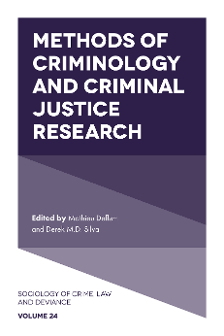
Index
Methods of Criminology and Criminal Justice Research
ISBN: 978-1-78769-866-6, eISBN: 978-1-78769-865-9
ISSN: 1521-6136
Publication date: 26 August 2019
Citation
(2019), "Index", Deflem, M. and Silva, D.M.D. (Ed.) Methods of Criminology and Criminal Justice Research (Sociology of Crime, Law and Deviance, Vol. 24), Emerald Publishing Limited, Leeds, pp. 195-200. https://doi.org/10.1108/S1521-613620190000024018
Publisher
:Emerald Publishing Limited
Copyright © 2019 Emerald Publishing Limited
INDEX
Index
- Prelims
- Introduction: Measuring Crime and Criminal Justice
- Part I: General Patterns and Trends
- Chapter 1: Is Crime Rising or Falling? A Comparison of Police-Recorded Crime and Victimization Surveys
- Chapter 2: Using Freedom of Information Requests in Socio-Legal Studies, Criminal Justice Studies, and Criminology
- Chapter 3: Criminal Group Dynamics and Network Methods
- Part II: Special Groups and Problems
- Chapter 4: Innovative Methods of Gathering Survey Data on Violence Against Women
- Chapter 5: Methods of Male Sex Work Research: Recommendations and Future Research Opportunities
- Chapter 6: Employing Mixed Methods: The Case of Elder Financial Exploitation
- Chapter 7: Perceptions of School Safety in the Aftermath of a Shooting: Challenge to Internal Validity?
- Part III: Crossing Boundaries
- Chapter 8: Methodological Challenges in Collaborative Research with Immigrant Women Experiencing Intimate Partner Violence in Canada
- Chapter 9: The Uses and Limits of Photovoice in Research on Life After Immigration Detention and Deportation
- Chapter 10: Agency Records as a Method for Examining Human Trafficking
- Chapter 11: Searching for Extremist Content Online Using the Dark Crawler and Sentiment Analysis
- Index